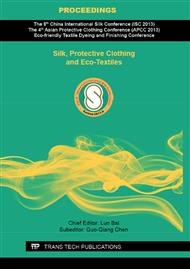p.577
p.584
p.588
p.593
p.601
p.607
p.613
p.617
p.623
Orthogonal Numerical Analysis on Thermal Stress of the Pilot Wearing Anti-G Suit with Phase Change Materials
Abstract:
To investigate heat and moisture transfer mechanisms of the pilots anti-G suit with phase change materials and improve the thermal performance of the garment, a mathematical model for pilot-anti-G suit-environment system is developed. In the model, the coupled heat and moisture transfer and thermal regulation process of phase change materials (PCM) in the anti-G suit are considered, and an 85-node thermal regulatory model is used to simulate human thermal responses. The model is validated by literature experimental data. Then, the parameter effects of PCM on the thermal stress index of the pilot are analyzed based on orthogonal calculation method by utilizing the model. Conclusion shows that the more PCM content and higher latent heat become, the less thermal stress index is.
Info:
Periodical:
Pages:
601-606
Citation:
Online since:
September 2013
Authors:
Price:
Сopyright:
© 2013 Trans Tech Publications Ltd. All Rights Reserved
Share:
Citation:


